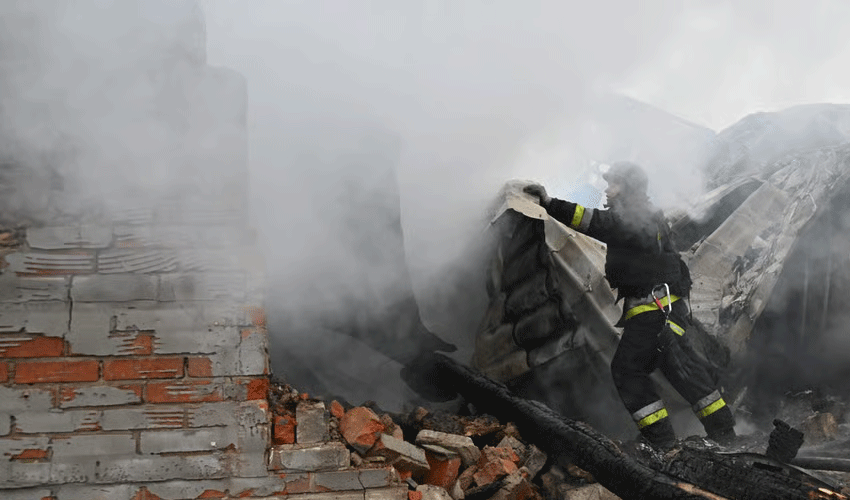Russia on Sunday launched the largest drone attack on Ukraine since the beginning of its full-scale invasion in 2022, killing at least one civilian and injuring several others, just a day before U.S. President Donald Trump is due to hold critical ceasefire talks with Russian President Vladimir Putin.
According to the Ukrainian Air Force, Moscow fired a record 273 drones overnight, targeting multiple Ukrainian cities, including the capital Kyiv and its surrounding regions. The previous record for a single-day drone barrage had been set earlier this year in February.
In the Obukhiv region, west of Kyiv, homes were reduced to rubble as residents described the terrifying sound of drones descending overhead. One of the victims, a 28-year-old woman, was killed when her house was hit, while three others, including a four-year-old child, sustained injuries.
“I could clearly hear the drone flying right towards my house,” said Natalia Piven, 44, who survived by sheltering in a cellar with her son before escaping to a local kindergarten’s bomb shelter. “I cannot get over it. I simply cannot.”
Ukrainian authorities confirmed widespread damage to civilian infrastructure, calling the attack a deliberate attempt to inflict terror and escalate pressure ahead of planned diplomatic engagements.
The drone strikes came amid heightened speculation that Moscow might launch an intercontinental ballistic missile (ICBM) later in the day. Ukraine’s intelligence agency said such a move would be intended to intimidate Western governments. However, there was no immediate response from the Kremlin regarding the allegation.
Zelenskiy Seeks to Rebuild Ties with Washington
Ukrainian President Volodymyr Zelenskiy, who has faced challenges in maintaining strong relations with Washington following a politically fraught visit to the White House in February, met on Sunday with U.S. Vice President JD Vance and Secretary of State Marco Rubio in Rome. The meeting was held on the sidelines of the inauguration of Pope Leo.
Calling the encounter “good,” Zelenskiy shared images of the informal meeting, showing Ukrainian and American officials seated around a table outdoors. Ukrainian media reported the discussions lasted 40 minutes.
“I reaffirmed that Ukraine is ready to be engaged in real diplomacy and underscored the importance of a full and unconditional ceasefire as soon as possible,” Zelenskiy said after also meeting the new pope.
The diplomatic push comes as Ukraine and Russia, under mounting U.S. pressure, held their first direct talks in more than three years on Friday. The two sides agreed to a significant prisoner swap involving 1,000 detainees each. However, attempts to broker a ceasefire faltered after Moscow presented a list of demands deemed unacceptable by Ukrainian negotiators.
A member of the Ukrainian delegation described the Russian conditions as “non-starters.”
Trump-Putin Call Looms Large
President Trump, who has promised to bring the war to a swift end, is scheduled to speak with President Putin on Monday. The upcoming call has triggered a flurry of diplomatic activity across Europe. German Chancellor Friedrich Merz said the leaders of France, Britain, Germany, and Poland would first consult with Trump in a bid to shape a united Western response.
European leaders, fresh from a joint visit to Kyiv last week, are urging Trump to endorse a new round of sanctions against Russia should Moscow fail to show flexibility in the upcoming talks.
Asked about the prospects of imposing stricter economic penalties on Moscow, U.S. Treasury Secretary Scott Bessent said the decision ultimately rests with Trump.
“President Trump has made it very clear, that if President Putin does not negotiate in good faith, the United States will not hesitate to up the Russia sanctions along with our European partners,” Bessent said.
Disputed Peace Terms
While Zelenskiy has expressed readiness to accept Trump’s proposal for a 30-day unconditional ceasefire, Russia insists that any truce must be accompanied by security guarantees. Among Moscow’s demands are the cessation of Western arms deliveries to Ukraine, recognition of Russia’s territorial claims, and Ukraine’s demilitarisation and adoption of a neutral status.
Kyiv has rejected those conditions, arguing they would amount to surrender and leave the country vulnerable to future aggression.
Trump’s position on the conflict has notably shifted from that of his predecessors. While previously advocating strong support for Ukraine, he has in recent months adopted a stance that partially aligns with Russia’s narrative, a development that has unsettled U.S. allies in Europe.
Despite the escalating attacks, Zelenskiy maintains that diplomacy remains the only viable path forward.
“Ukraine does not fear peace talks. But peace cannot come through threats, drones, and ultimatums,” Zelenskiy said.



